The number of students taking Advanced Placement exams and entering college with college credit is continuing to rise, according to a report by the College Board.
The number of high school graduates who took one or more AP tests in 2006 increased from roughly 645,000 to 903,000, and MU has seen a similar increase.
Although these high school classes are supposed to operate on a higher level of difficulty than the typical high school class and give college credit as a reward for good test scores, the value of gaining AP credit has been the subject of debate between students and university officials.
Gaining college credit itself isn’t controversial, but whether it benefits the student who continues to take higher level courses in that subject is the question. For example, AP Biology is standardized across the nation, meaning all students in that class learn the exact same thing. Not all beginning biology classes in college operate that way. Because of this, there is a chance that students with AP credit in biology will have missed something by skipping the introductory classes and end up behind the students who did not come to school with credit.
Freshman Will Moritz sees both the pros and cons of AP credit.
“The AP courses generally prepare you for college level learning and allow students to take more courses they are interested in … of course, if you are majoring in a subject that you have AP credit for, then using it could be a hindrance more than anything,” he said.
Senior associate director of admissions Chuck May said he sees only benefits in incoming freshmen having AP credit.
“The professors of each subject have access to information about the AP tests,” he said. “They are the ones that determine what score is necessary for a student to gain credits.”
May said students with credit in classes like biology should not fall behind or miss anything by skipping the beginning level classes because it is the biology professors themselves who determine how much credit they think the AP test is worth.
According to the university registrar website, between 2006 and 2011 the average number of credit hours brought in by students actually fell from 11.3 to 11.2. On the other hand, the number of students bringing the credits in has risen drastically since 2006.
May said this is because “more rural high schools are starting to offer AP credit classes, though maybe only one or two per school.”
He said this explains why the average amount of credits has fallen, because though a greater number of high school students can earn credit, they might be limited to how many AP classes they can actually take.
In theory, all this college credit should reduce the amount of time it takes to graduate, but it can help students in a variety of other ways in the long run.
“Students coming in with credit may reduce credit hours each semester in order to get a job and work more, take on a minor, or pick up a double major,” May said.







